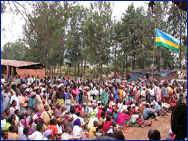 People People |

Population: 8 million. The most recent government
estimates put the population of the tiny country
at 8.2 million.Rwanda says it has began its first
census since the genocide in 1994, which killed
an estimated 800,000 people and forced hundreds
of thousands more to flee.Government officials say
the census is aimed at establishing an accurate
figure for its rapidly-growing population to help
efforts to fight poverty. The census will run from
16-30 August. Up to 2.5 million people are estimated
to have returned to Rwanda since the genocide.
The last census was conducted in 1991 and showed
the population had grown to 7.15 million, from 4.7
million when the first census was carried out in
1978. The urban concentrations are grouped around
administrative centers. The indigenous population
consists of three ethnic groups.
|
The Hutus, who comprise
the majority of the population (85%), are farmers
of Bantu origin. The Tutsis (14%) are a pastoral
people who arrived in the area in the 15th century.
Until 1959, they formed the dominant caste under
a feudal system based on cattle holding. The Twa
(1%) are thought to be the remnants of the earliest
settlers of the region.
Annual growth rate: More than 3%.
Religions: Christian 93.5%, traditional African
0.1%, Muslim 4.6%, 1.7% claim no religious beliefs.
Languages: French, English, and Kinyarwanda.
Education: Years compulsory--6. Attendance--75%
(pre-war). Literacy--64%.Over half of the adult
population is literate, but not more than 5% have
received secondary education. During 1994-95, most
primary schools and more than half of pre-war secondary
schools reopened. The national university in Butare
reopened in April 1995; enrolment is over 7,000.
Rebuilding the educational system continues to be
a high priority of the Rwandan Government.
Health: Infant mortality rate--107/1,000.
Life expectancy--40 yrs.
Work force: Agriculture--92%; industry and
commerce, services, and government--8%.
|

